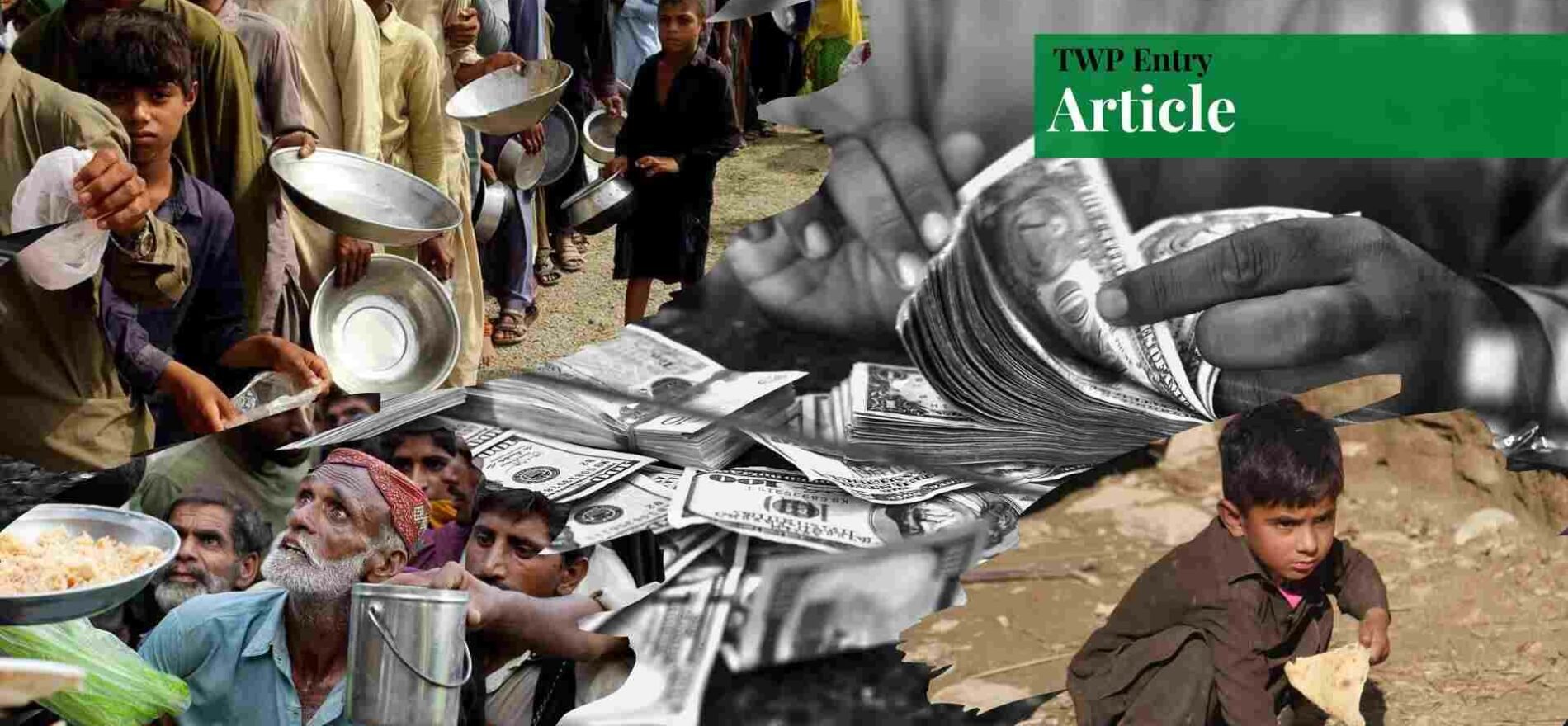Ms Rida Raja has an undergraduate degree in Economics from COMSATS University Islamabad.
Currently, Pakistan is faced with several economic challenges which include a balance of payments crisis, soaring inflation, mounting debt obligations, and persistent budget deficit, among others. However, the debate around these macroeconomic issues tends to be heavily politicized and therefore, the approach to look at them often also loses focus on the underlying economic determinants at play. To understand these economic issues better, it is imperative to analyze them through an economic lens, to devise evidence-based policies.
Decoding Pakistan’s Economic Woes
One of the economic challenges of Pakistan is that the country has been trapped in a destructive state of no sustainable economic growth over the past 5 decades. This is precisely why today it stands on the verge of default, which would already have been the case, had there been not the lender of the last resort, the International Monetary Fund (IMF).
If one were to diagnose one of the root causes of the country’s today’s economic instability, it could be summed up in this statement made by Paul Krugman, an American economist, “Productivity is not everything, but, in the long run, it is almost everything.’’ To simplify, the output growth of an economy comes either from the expansion of inputs or by increasing the productivity of these inputs. However, an economy’s long-term well-being is highly contingent upon its total factor productivity, or simply productivity.
In layman’s language, productivity can be defined as the amount of output that can be generated from a given amount of inputs. This reflects the effectiveness with which the inputs in the production process are being utilized. An analysis of Pakistan’s economic history shows that the country’s productivity growth rate, and therefore, its GDP growth rate and exchange rate have been on an overall downward trend since the early 1970s. Pakistan has repeatedly required the assistance of the IMF programme. With each new government, this issue has only increased. The working paper by PIDE further reveals that the GDP growth rate has primarily been influenced by an increase in the quantities of inputs in the production processes, except for the eras of the 1980s and 2010s.
These findings have important implications for policymakers; the mere accumulation of inputs never guarantees sustainable economic growth or economic recovery,, and it is the productivity of the factors of production that was required by Pakistan all along to avoid its current state of economic challenges.
There is strong evidence that supports this direct positive linkage between total factor productivity and sustainable economic growth rate. For instance, for the nations of G-7, G12, and G-20, it has been found that the total factor productivity has been a more significant contributor to the economic growth of these nations than that of the accumulated factors themselves.
A Struggle to Save Pakistan’s Economy
The long-term growth of an economy is determined crucially by the way its income is spent. In the case of Pakistan, consumption expenditure has consistently taken such a huge proportion of the country’s income that very little is left for savings, and therefore, investment. An analysis of the data from the Pakistan Economic Survey FY2022 would help to understand the precarious situation of the consumption-oriented economy of Pakistan.
As per PES 2021-22, the total consumption formed 96.2% of the country’s GDP; to further disaggregate, household private consumption accounted for 85.2% of the GDP. This means a major proportion of an average Pakistani citizen’s income goes into consumption, leaving an insignificant part of it for savings. Unfortunately, this has remained the case for the past three decades.
On the other hand, the total investment as a percentage of GDP is stuck at 14% to 15% for the past three years. The different versions of Pakistan’s economic surveys also show that in the past decade, the investment-to-GDP ratio mostly remained at this level, except for 2017-18.
In the 2000s, this ratio was comparatively higher reaching up to 22.5% in 2006-07. This demonstrates that the country has only deteriorated in terms of investment to GDP ratio with time. However, a downfall in the country’s overall propensity to invest can be traced back to as early as the mid-1980s. To sum it up, Pakistan being a consumption-led economy, has failed to generate enough domestic/national savings to support the level of investment needed for sustained economic growth. Instead, it has continued to pile its external debt.
Export Enigma: Can Pakistan Crack the Code to Sustainable Growth?
The performance of Pakistan’s export sector is not competitive globally, both in terms of quantity and quality. It can be demonstrated from the fact that in 2023, the country’s exports stood at US$31.55 billion, which is far below its true potential of US$88.1 billion. Since the past five decades, the real export growth has mostly remained volatile and patchy. There are several reasons for this, including the energy crisis, limited trade openness, regular floods, and institutional rigidities, among others.
However, one of the primary reasons for the poor performance of the export sector is that it is highly concentrated in a few items; cotton manufacturers, leather, and rice form almost 70% of Pakistan’s total exports. In other words, the country’s export sector is primarily being driven by the low-tech, low-end textile industry.
To further emphasize, more than half of Pakistan’s export earnings come from labor-intensive and light-manufacturing products; it is important to recognize that without value-addition, it is impossible to thrive in today’s highly competitive international markets. Another dimension to this problem is the country’s trading destinations. Historically, the US, China, and the European Union have been Pakistan’s top trading partners; however, the country remains far from tapping its full trade potential;
Take the South Asian region, for instance, the country’s trade potential with the region is $67 billion, but it is only being captured up to $23 billion. Considering the bilateral trade, India could be a significant trading partner in terms of export destination for Pakistan, as the trade potential between the countries is $37 billion, but only $2.3 billion is being utilized. These numbers present the country’s failure to identify and capture the markets with the potential of developing a comparative advantage.
Moreover, there is significant untapped potential for further enhancement even in the country’s current export and trade destinations, which also remain unaddressed. These factors certainly limit Pakistan’s ability to integrate into the global value chains (GVCs). Today, the scale and structure of international trade are dominantly governed by GVCs.
Pakistan has been slow in catching up with this development, as only 33.2% of the country’s exports are involved in the global value chains. A comparison with the other lower-income middle countries, such as Vietnam and India that have their total global value participation at 57.1% and 40%, respectively, clearly shows that they have been outpacing Pakistan.
Solutions for Economic Challenges Faced by Pakistan
Reforms in the Agriculture Sector
In the agriculture sector, the productivity of our major crops’ yield needs to be enhanced, as it has remained consistently less than half as productive as that of other countries. To do so, an equitable and efficient distribution of water through a properly mechanized and modern irrigation system must be done.
Furthermore, the digital inclusion of farmers certainly enhances the value-addition in agriculture. This is particularly crucial for Pakistan, as most of its farmers lack modern skills and education. A practical example of such a policy reform is M-Kilimo, which is a mobile helpline in Kenya; it provides access to the farmers to gain all sorts of information related to agriculture by communicating with the agriculture experts on the phone. This includes information related to agricultural goods and services, market prices, weather forecasts, and other queries related to livestock and crops.
Pakistan should adopt vertical farming on a larger scale in order to enhance its production on smaller land holdings. In order to develop an export-oriented agriculture sector, that is globally competitive, it is imperative to invest in rural infrastructure, as well as in better seed and soil research, and soil testing.
Revitalizing Industrial Sector
Pakistan is not a highly industrialized nation; the textile sector is the only backbone of the country’s industrial sector. The importance of the textile sector can be realized from the fact that it is the source of more than 60% of the country’s export products. However, Pakistan has a long way to go before it can develop a strong industrial base, which is certainly a need of the hour given the country’s burgeoning population and the need for employment opportunities that would only be increasing over time. It would also help bring economic stability to a country that faces multifaceted challenges.
Pakistan needs to simplify and ease its regulatory processes; they are extremely difficult and lengthy, and therefore, discourage investment in the industrial sector. The importance of these policy reforms in this area can be realized from Singapore, a country that has one of the world’s most favorable regulatory environments for businesses, making it highly optimal for domestic entrepreneurs to invest and one of the most competitive economies across the globe.
Another important area to focus on is the human capital. An innovative and advanced industrial sector in any economy demands highly skilled labor. Therefore, measures such as the ‘dual education’ system, which is practiced in countries like Germany should also be implemented in Pakistan by the government. In this system, education along with on-the-job training is practiced equipping the individuals with essential knowledge and skills.
Most importantly, the energy crisis has remained a persistent bottleneck for the country’s industrial growth. In order to resolve it, Pakistan should bring changes to its energy mix; more focus should be given to the development of renewable energy sources such as solar power. For the current energy infrastructure, it is important to upgrade the transmission and distribution network to improve the efficiency and conservation of the energy sector.
Improvement in the Services Sector
The services sector has the largest share of the country’s GDP; the service value-added being more than 50% of the country’s GDP. However, in comparison to countries like India, Pakistan’s services sector is comparatively not as competitive, internationally. A range of reforms needs to be taken in this sector of the economy as well. Building human capital is the key to the growth of the services sector, and therefore, investment needs to be made in education and skill building.
Considering the country’s growing problem of young population and that too with very limited jobs in the domestic market, an efficient strategy would be the introduction of short-term degrees or courses that would focus on the skills that have high demand internationally. For example, the youth could be equipped with the skills required for freelancing. These include graphic designing, academic writing, digital marketing, etc.
This way while the Pakistani economy deals with the crisis of twin deficits and debt obligations, the problem of unemployment and poverty could be somewhat efficiently tackled with this strategy. Certainly, with the current economic crisis, it is impossible for the government to create large job opportunities in the domestic market in the short run. Unlike other states, Pakistan hasn’t even tapped into the full potential of remittances from its diaspora. This is why it is important for the government to realize the need to deal with the crisis of food insecurity and unemployment that it would have to deal with in immediate term. If these looming issues are not given attention, they will lead to social unrest in the country further adding to the country’s economic crisis.
If you want to submit your articles, research papers, and book reviews, please check the Submissions page.
The views and opinions expressed in this article/paper are the author’s own and do not necessarily reflect the editorial position of Paradigm Shift.



















